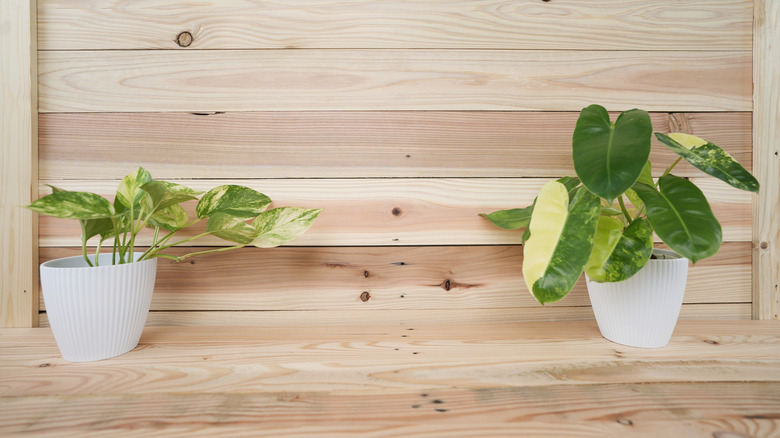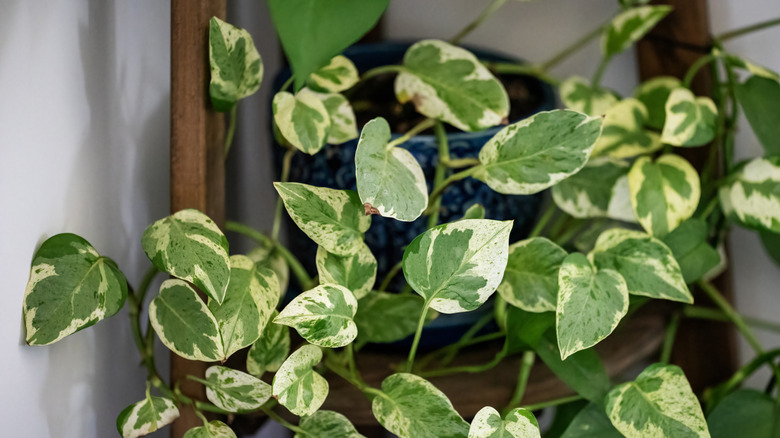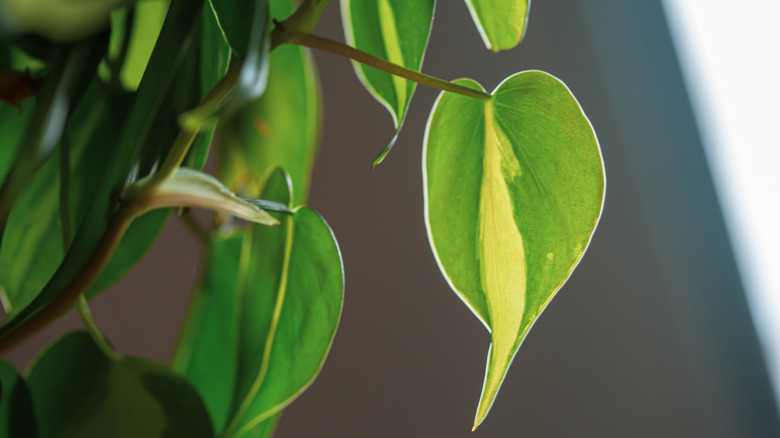Pothos And Philodendron: The Biggest Differences And Which Is Right For Your Home
Almost every houseplant lover will find themselves growing an indoor pothos at one point or another. Or is it philodendron? Both of these plants are incredibly common, low-maintenance houseplants, and they look so similar that they're often mistaken for one another. But in other ways, they're quite different: philodendrons come in a much wider variety of species, can tolerate low light better, and prefer higher humidity, among other important distinctions.
Both pothos and philodendrons are part of the Araceae family of flowering plants, which consists of 4000 species in total (many of which are familiar houseplants). The pothos genus, Epipremnum, has 15 species total, while the philodendron genus, Philodendron, contains more than 450 species. There's a reason the two are often in the same section of the plant store and recommended alongside each other: they prefer similar types of soil and lighting, and both are foolproof enough that beginners can easily keep them alive. Some species are lookalikes of each other as well: they're all climbing or trailing plants with heart-shaped leaves.
When people say "pothos," they are usually referring to one species in the relatively small Epipremnum genus, the ever-popular Epipremnum aureum. While there are many varieties of pothos available with different colors, they all have the same basic shape. The philodendron genus, on the other hand, is very diverse; there is a wide variety of sizes, leaf shapes, and colors among its species. Any of these houseplants are perfect for growing indoors, but philodendrons and pothos have slightly different care needs and may thrive in different environments. Note that both are toxic to people and pets if eaten.
Is a pothos right for your home?
Pothos come in different colors with leaves that are marbled or solid, light or dark. Aside from the main pothos species, there is also Epipremnum pinnatum, which has monstera-like holes, and Epipremnum amplissimum, which has long and skinny leaves. But all pothos species are great for beginners because they're so easy to care for. They can grow in rooms with low light levels, though they prefer bright, indirect light. They will grow up to around 10 feet long as a vining houseplant and can also be trained to grow in a bushier shape. They require well-draining, nutrient-rich soil.
Pothos leaves are typically bigger, thicker, and lighter than philodendron leaves and have a less distinct heart shape. Pothos are native to southeast Asia and the Pacific Islands, unlike philodendrons, which are native to tropical regions in the Americas. Variegation — or different colors on the same leaf — is more common in pothos than philodendron, and all pothos are climbing plants. Another difference is that pothos have one larger aerial root on each node, and climbing philodendrons have smaller, more numerous aerial roots on each node.
If you're a complete beginner to houseplants, a pothos is likely a better choice than a philodendron since it doesn't mind drying out somewhat between waterings — in fact, it prefers to. If you live in a drier area, a pothos will be more tolerant of minimal indoor humidity levels than a philodendron. And while both pothos and philodendron can grow in low light, philodendron is the more tolerant pick, so it's better if you're dealing with a space that's quite dark.
Is a philodendron right for your home?
Philodendrons have tons of variety to offer. Heart-leaf philodendron (Philodendron scandens) looks the most similar to pothos. But there's also tree philodendron (Philodendron bipinnatifidum) with its large, deep-cut leaves and red-leaf philodendron (Philodendron erubescens) with its signature reddish leaves, among many other philodendrons with different shapes, sizes, and colors. Vining philodendrons are most common, but many grow upright as well.
Compared to pothos, vining philodendrons have more symmetrical, distinctly heart-shaped leaves that are curved at the base where they meet the stem. The leaves are thinner, smoother, and usually darker than pothos, and variegation is less common. Philodendrons also have visible stipules, little growths next to the leaf node, on new growth; the stipules fall off on older growth. And unlike pothos, philodendrons will sometimes produce baby plants.
If you're ready to spend a little more time watering and monitoring soil levels, try a philodendron. It requires consistently moist soil, but the soil should not be drenched, or you risk root rot. Philodendrons and pothos have similar fertilization needs — just a couple times a year will do — but philodendrons can use more nitrogen for the leaves. Also, if you live in a humid area or often use a humidifier, a philodendron will feel right at home in your house, with its higher humidity needs than pothos. A philodendron can also tolerate a wider range of light conditions, making it a better plant for dark areas; choose a non-variegated philodendron for this purpose (and remember that all plants need some light to grow).


